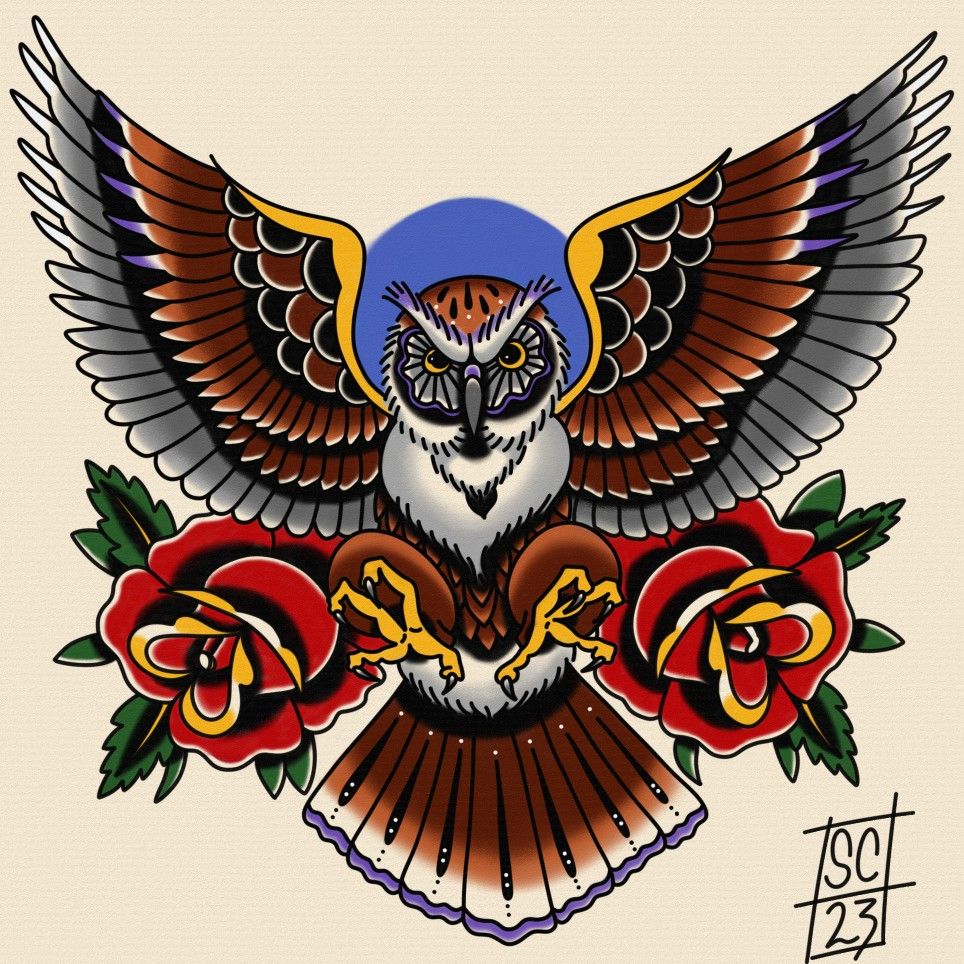American Traditional tattoos, also known as old-school tattoos, are recognizable by their bold outlines, limited color palettes, and iconic imagery. Amongst the panoply of classic motifs, the owl holds a particularly intriguing place. This compendium delves into the world of American Traditional owl tattoo flash, exploring the symbolism, design elements, and enduring appeal of these avian emblems.
The owl, a creature cloaked in nocturnal mystery, has captivated human imagination for millennia. In many cultures, it embodies wisdom, knowledge, and foresight. This symbolic weight translates beautifully into the realm of tattooing. A classic owl tattoo can represent a quest for enlightenment, a connection to the unseen, or simply an appreciation for the bird’s inherent mystique. It is a potent glyph, ripe with connotative layers.
American Traditional owl tattoos, however, are not mere reproductions of naturalistic owls. Instead, they are stylized depictions, adhering to the aesthetic principles of the genre. Thick, unwavering lines define the owl’s form, providing structure and visual impact. These bold contours are essential, ensuring the tattoo’s legibility and longevity, even as the ink ages and spreads subtly beneath the skin.
Color usage is typically restrained, favoring a palette of primary hues—reds, yellows, blues—along with black and occasionally green. These colors, applied in solid blocks with minimal shading, contribute to the tattoos’ striking visual presence. The simplicity of the color scheme, however, belies the artful arrangement and strategic placement of each shade, creating depth and dimension within the two-dimensional confines of the design.
Examine the individual components that comprise the archetypal American Traditional owl: its piercing gaze, rendered with unwavering clarity; the symmetrical arrangement of its feathers, often depicted in stylized patterns; the talons, firmly gripping a perch or scroll. Each element is meticulously crafted, contributing to the overall symbolic narrative. The owl’s eyes, for example, are frequently emphasized, serving as windows into the bird’s profound understanding of the world.
Beyond the technical aspects, the enduring appeal of American Traditional owl tattoos lies in their ability to convey complex ideas with remarkable simplicity. The owl can be interpreted as a guardian, watching over its wearer with silent vigilance. It can also represent a seeker of truth, forever pursuing knowledge and understanding. This symbolic versatility makes the owl a fitting emblem for a wide range of individuals, each drawn to the bird’s unique attributes.
Consider the context in which these tattoos were originally conceived. Rooted in the maritime and military cultures of the early to mid-20th century, American Traditional tattoos were designed to be bold, easily identifiable, and deeply personal. The owl, with its association with wisdom and protection, resonated with sailors and soldiers facing the perils of the sea and the uncertainties of war. These tattoos served as talismans, providing a sense of connection to home and a reminder of the values they held dear.
The owl’s perch, often a branch or a banner, adds another layer of meaning to the design. The banner, a common feature in American Traditional tattoos, can be inscribed with a name, a date, or a motto, further personalizing the piece. This integration of text allows the wearer to express their individuality within the framework of a classic design.
The execution of an American Traditional owl tattoo requires not only technical skill but also a deep understanding of the genre’s history and conventions. A skilled tattoo artist will be able to translate a client’s ideas into a cohesive and visually compelling design that honors the traditions of old-school tattooing while also reflecting the individual’s unique personality.
Furthermore, the placement of the tattoo plays a crucial role in its overall impact. Owls are frequently rendered on the upper arm, shoulder, or chest, allowing for a larger and more detailed design. These locations also provide ample space for the tattoo to breathe, ensuring its legibility and visual prominence. The placement, like the design itself, is a deliberate choice, contributing to the tattoo’s overall aesthetic harmony.
American Traditional owl tattoos continue to captivate contemporary audiences. Their timeless appeal lies in their ability to blend symbolic depth with visual simplicity. These tattoos are not merely decorative adornments; they are potent symbols of wisdom, knowledge, and protection, rendered in a style that is both classic and enduring. The legacy of these avian emblems persists, a testament to the enduring power of American Traditional tattooing. The owl, eternally vigilant, remains a beacon in the landscape of inked art, a symbol of both knowledge and the mysteries that still lie beyond our ken.
